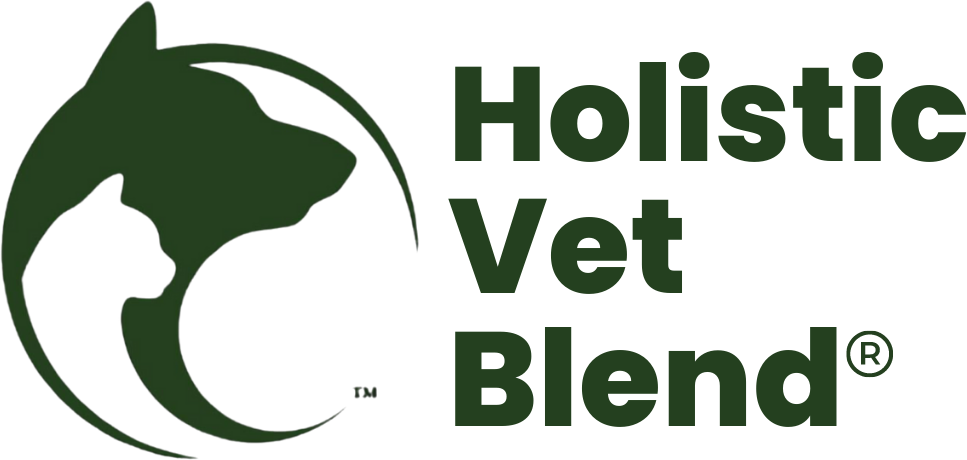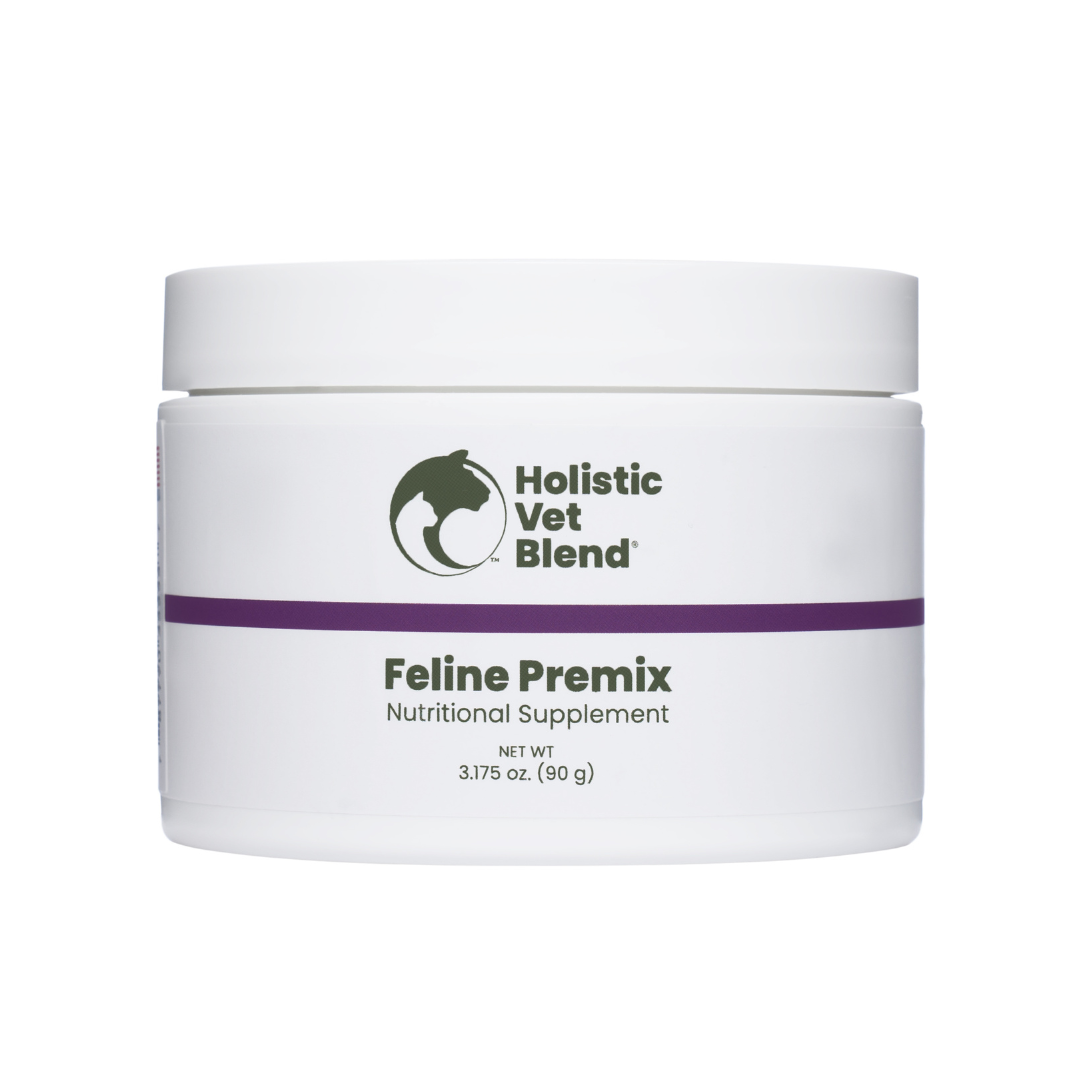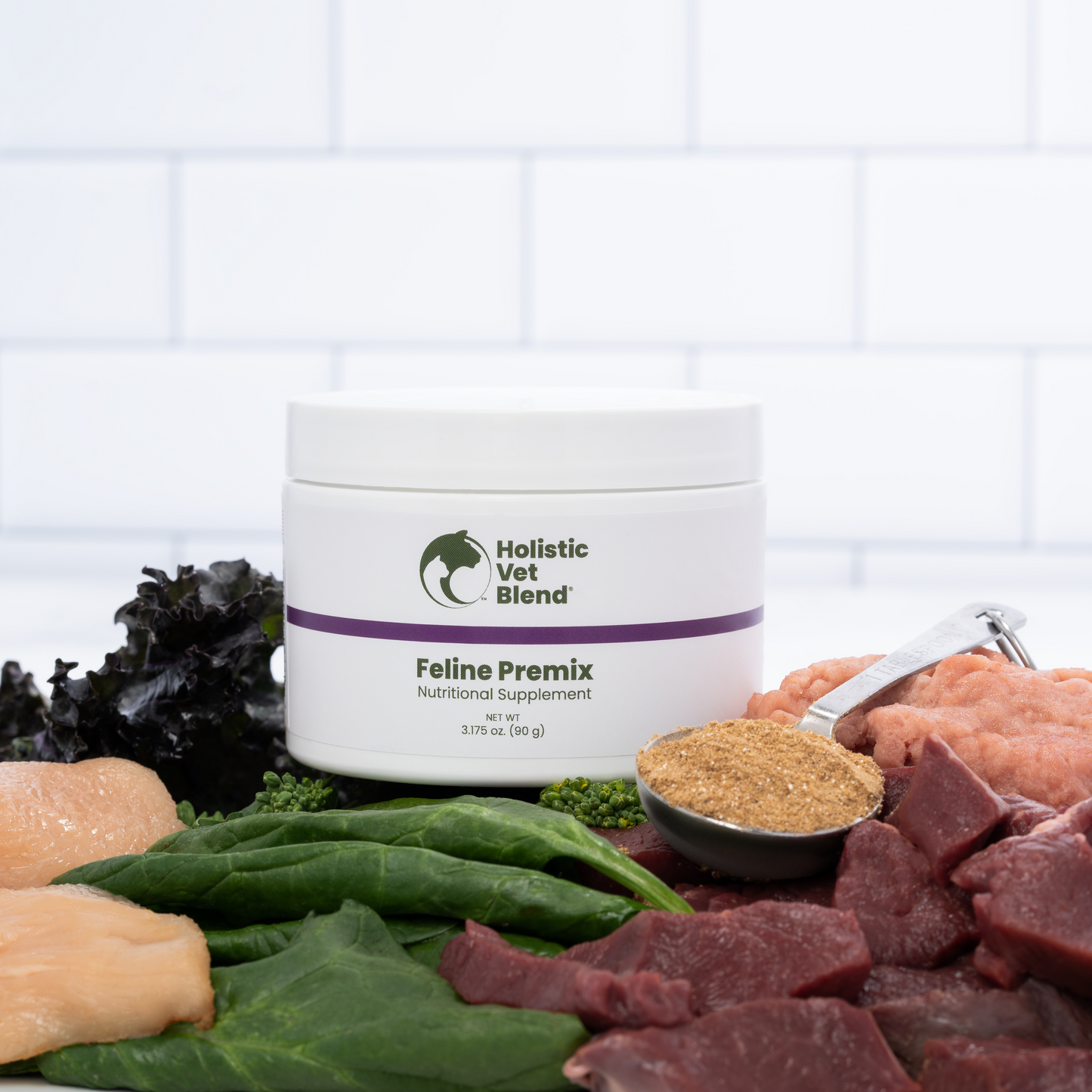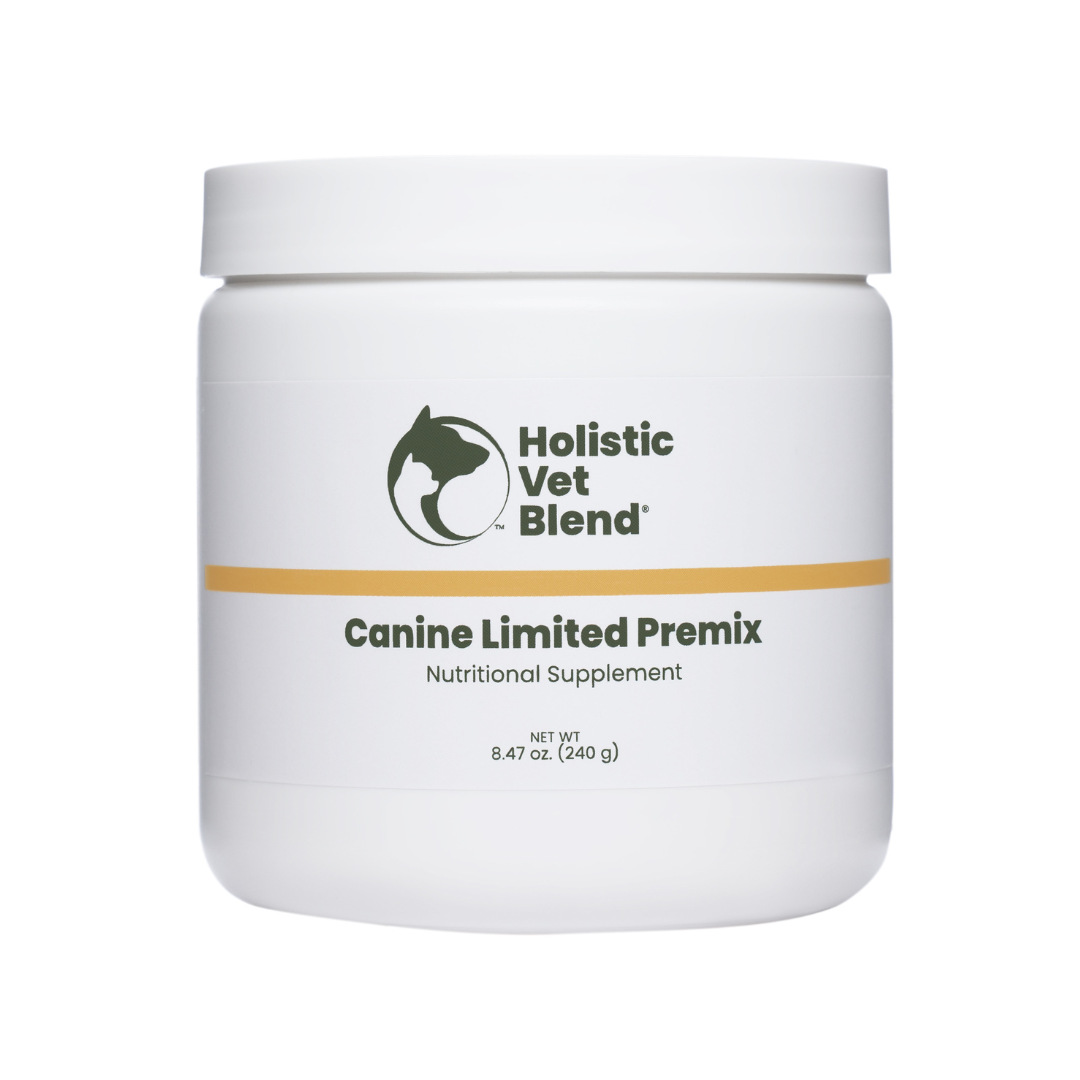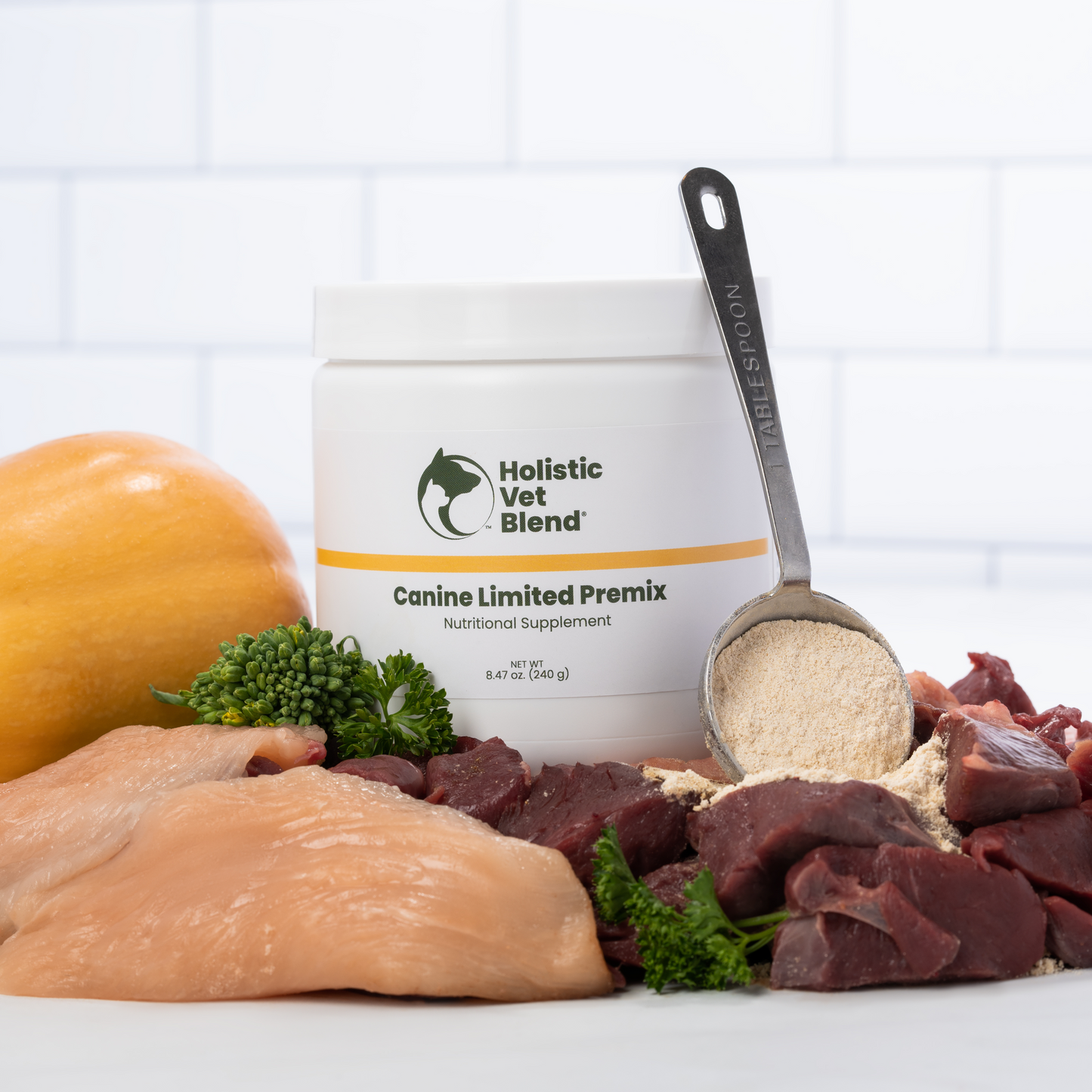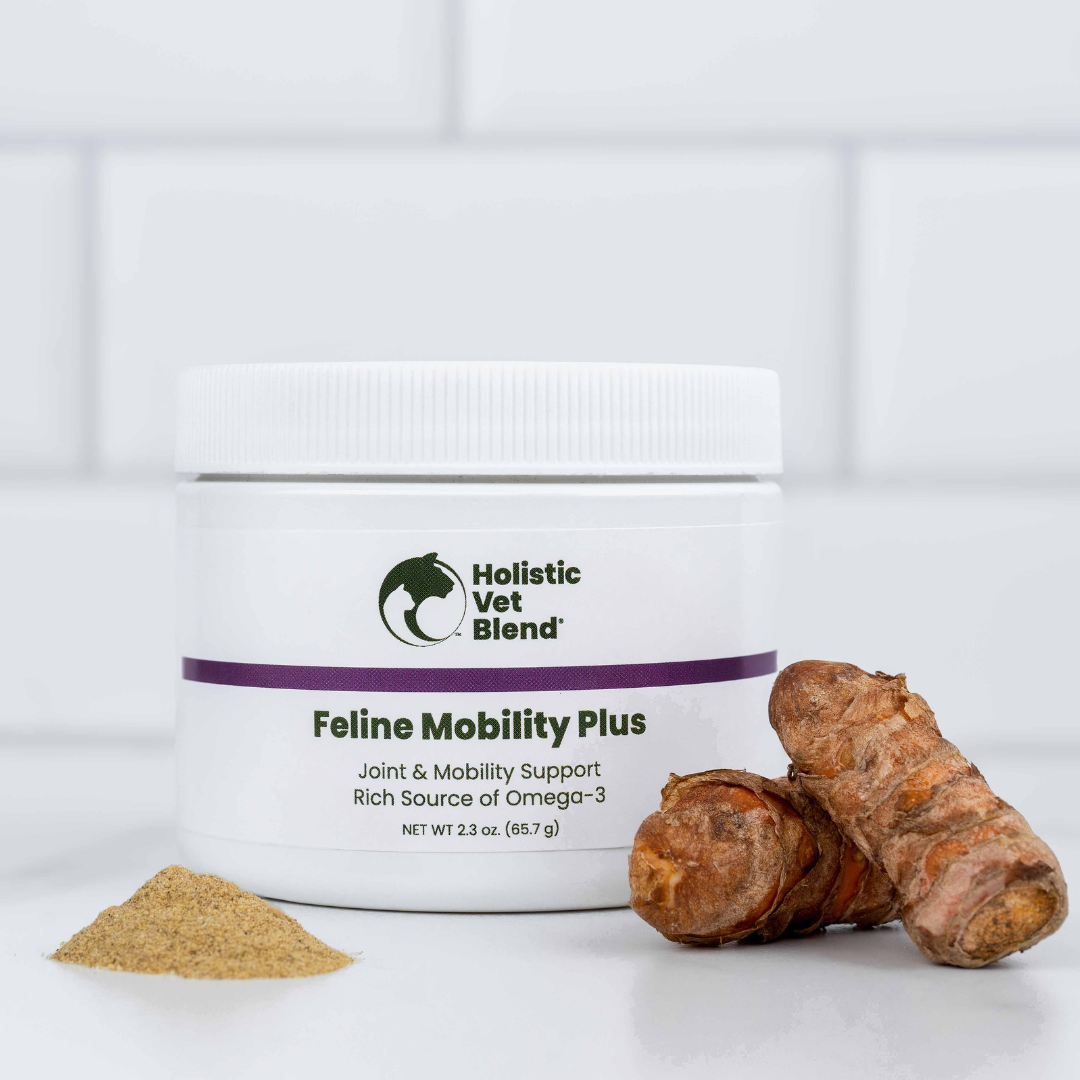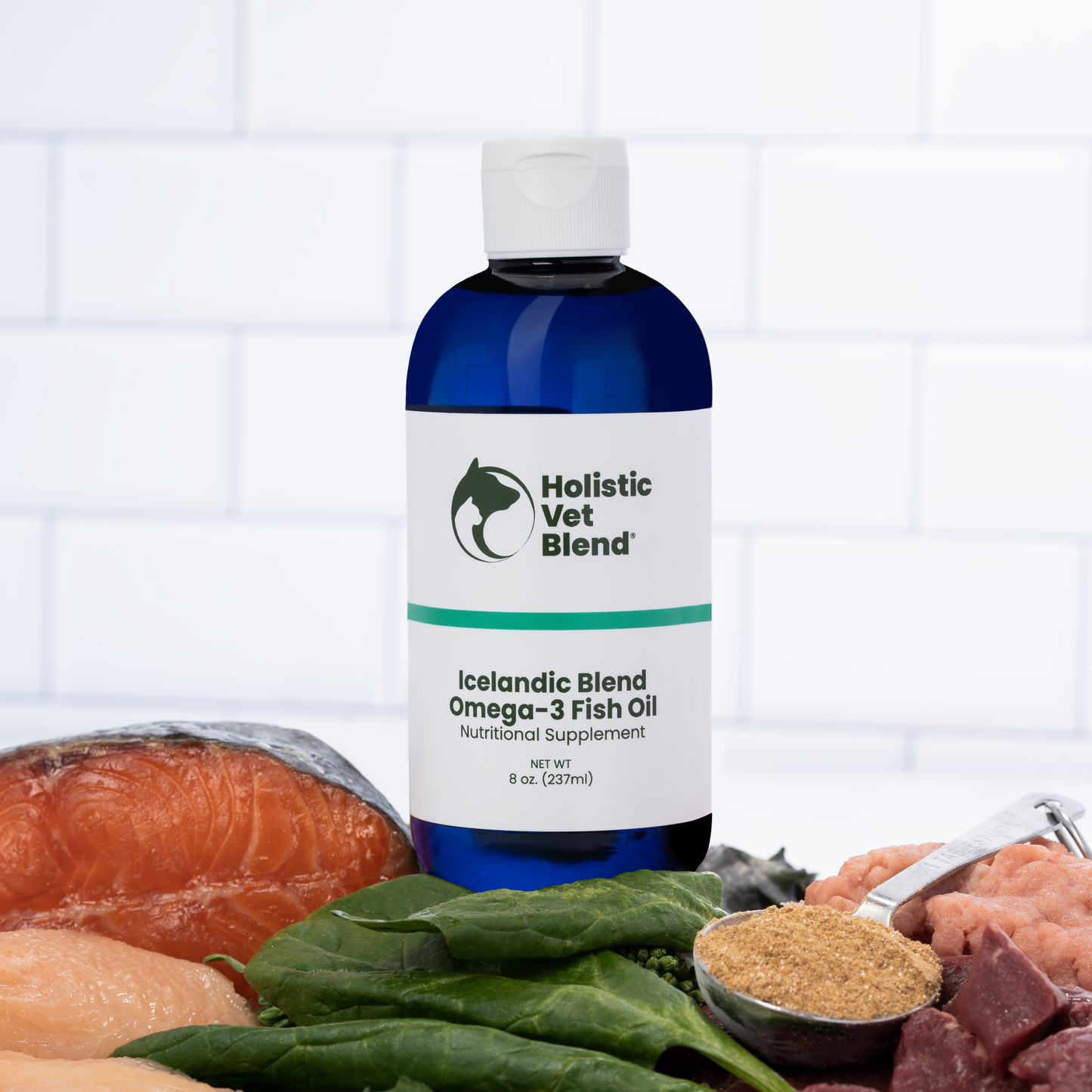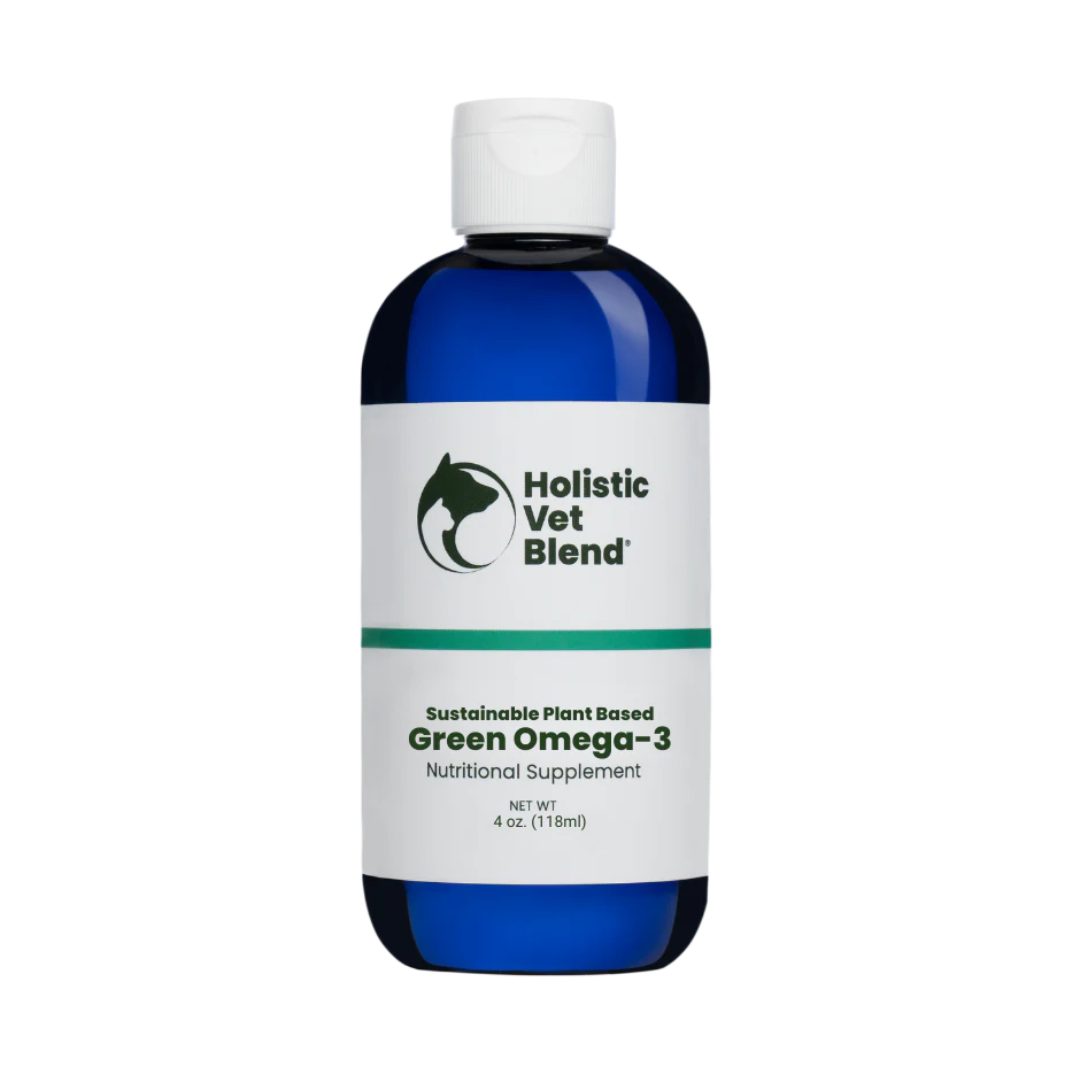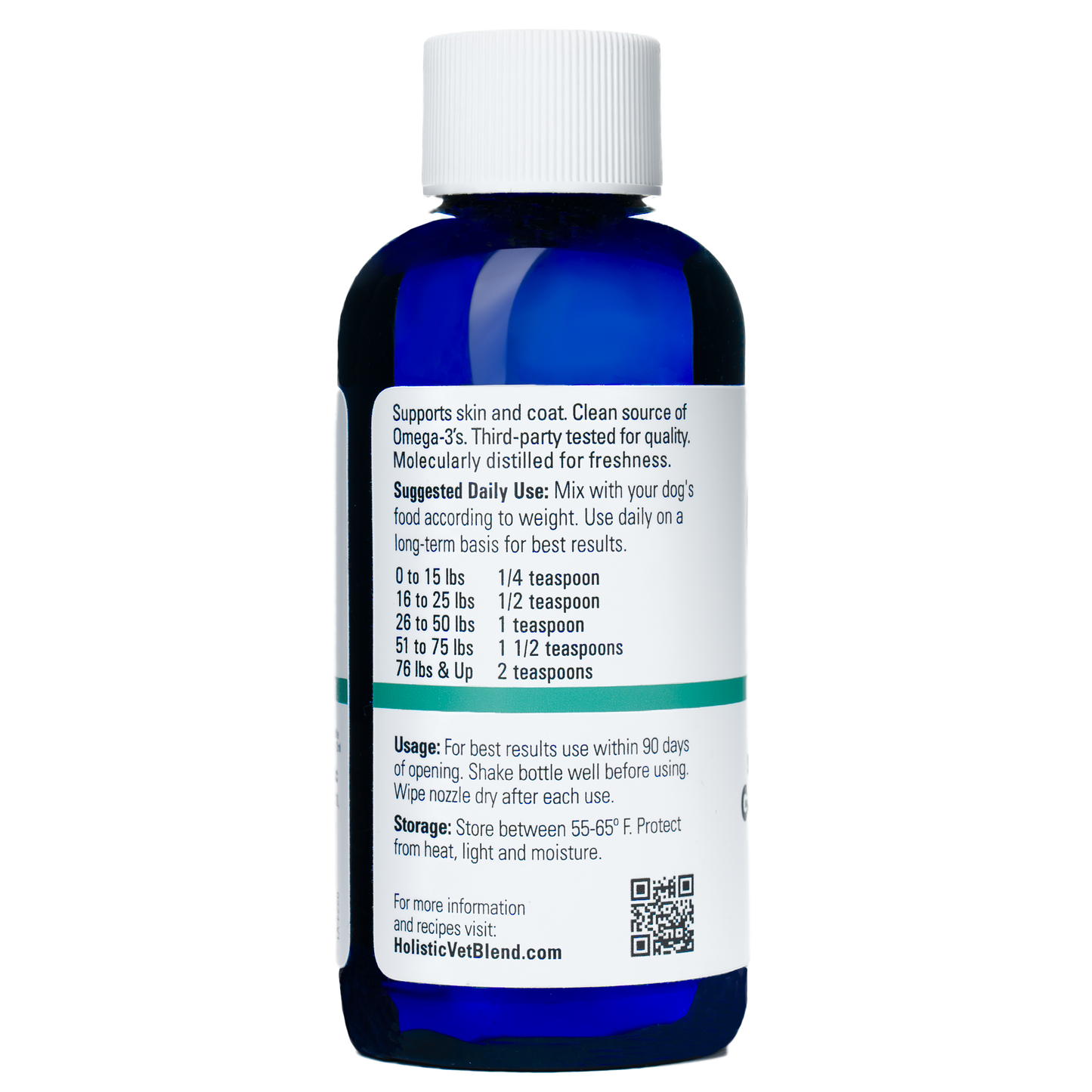
Are you ready to whip up a delicious and nutritious meal for your feline friend in just under 15 minutes? Making a homemade cat food recipe with ground chicken muscle meat and sardines is quick and easy and allows you to control the quality of the ingredients that go into your cat's bowl.
With human-grade ingredients at your fingertips, you can ensure that every bite is packed with goodness, including necessary nutrients. However, it's crucial to remember that while homemade meals can be a delightful treat for your cat, they must be balanced with essential nutrients for long-term feeding. This recipe is balanced with the Holistic Vet Blend supplement premix, which includes calcium, vitamins, trace minerals, and taurine. Grass-fed beef organ meat is a source of Vitamin D in this recipe, which means you don't have to deal with trying to find quality organ meat and deal with it (which I don't enjoy personally) for a balanced batch of food.
Key Highlights for Cat Owners
- Discover how quick and easy it is to make homemade cat food.
- Learn about how to add essential nutrients that complete the recipe
- Follow a step-by-step guide to prepare a nutritious chicken and sardine cat food recipe.
Introduction
You control what goes in your cat's bowl when you make homemade cat food. No more mystery gravy and faux meat shreds. Much of the meat that goes into cat food is unfit for human consumption, and some low-quality ingredients and additives are not the healthiest. There are many choices in commercial pet food, but making homemade cat food gives you more control over what goes into it. This guide will help you learn how to prepare tasty and healthy food for your cat at home.
What is a species-appropriate diet and the best option for an obligate carnivore?
Cats are obligate carnivores, meaning their bodies are specifically designed to thrive on a diet rich in animal protein, not carbohydrates. Feeding them carbohydrate-laden dry foods can lead to health issues, as these diets do not align with their natural dietary needs. Wet food is typically the healthiest option for cats, as they evolved from desert-dwelling ancestors who had limited access to water and, therefore, developed a low thirst drive. If you notice your cat drinking excessively, it could be a sign of chronic dehydration, early kidney disease, or diabetes. In such cases, it’s essential to transition them to a low carbohydrate wet food diet, which provides necessary moisture and protein levels, or seek veterinary advice and have blood work done to ensure their health. Prioritizing a diet that aligns with their biological needs is crucial for their well-being.
Benefits of a fresh food diet over a Commercial Diet
A fresh homemade diet offers numerous benefits over commercial cat food, primarily by providing higher quality, human-grade ingredients and the ability to customize meals to suit your cat's specific nutritional needs, including your cat's food preferences and dietary requirements. Unlike many commercial options containing fillers, artificial additives, and low-quality proteins, homemade cat food meals allow you to choose fresh, nutrient-dense ingredients from your cat’s food sources. This enhances your cat's overall health and vitality, supports better digestion, and can lead to a shinier coat and increased energy levels. Additionally, a fresh diet can help you avoid common preservatives and additives in processed foods, ultimately promoting a happier and healthier feline companion.
Making your own cat food is also a more sustainable practice, as 60-90 fewer cans or pouches will go to the landfill every month!
Does it take a long time to make your own cat food?
This recipe can be easily made in less than 15 minutes!
Step-by-Step Guide to Homemade Cat Food Recipe: Chicken and Sardine Cat Food
Are you ready to enhance your cat’s diet with a homemade meal that’s both nutritious and tasty? This Chicken and Sardine Cat Food recipe is perfect for even the pickiest eaters, offering wholesome ingredients that support your furry friend’s health and vitality. Not only does this recipe cater to your cat's preferences, but it also includes essential nutrients to ensure a well-rounded diet. Let’s explore the benefits of each ingredient and the significance of adding crucial nutrients to create a complete and balanced meal.
The Ingredients and Their Benefits
1 Pound of Meat: At Least 80% Fresh Meat Ground Chicken
Chicken is an excellent source of high-quality protein, and since cats like it, it is a good choice for introducing a cat to a homemade diet. Many people erroneously think their cat is allergic to chicken, but it's not chicken that they are allergic to, but all of the additives present in the food and not the chicken itself. Think about it: How many humans are allergic to chicken? I hear this all the time from pet owners. It's guilt by association with the other ingredients and chemicals that form during processing.
2 Tbsp Coconut Oil
Coconut oil is a source of Medium Chain Triglycerides (MCTs), which can aid digestion and provide quick energy. It also supports a healthy coat and skin, making it a great addition to your cat’s diet.
4.5 Ounce Can Sardines Packed in Water
Sardines are an excellent source of Omega-3 fatty acids, vital for skin health, coat shine, and overall immune function. These fatty acids also have anti-inflammatory properties that can benefit your cat's joints and cardiovascular health.
Egg (1-2 Eggs Optional)
Eggs are a complete protein containing all the essential amino acids your cat needs. They are also an excellent source of vitamins and minerals, making them a nutritious choice for your feline friend. I will be adding 2 eggs to this recipe. You must cook eggs as raw egg white has avidin, which will bind biotin. Cooking inactivates this.
1 Cup of Water, Low Salt Broth, or Bone Broth (No Garlic or Onions)
Adding liquid helps keep your cat hydrated and can enhance the meal's flavor. Bone broth is particularly beneficial for its collagen content, supporting joint health and digestion. You can learn how to make your own pet safe bone broth here.
½ tsp Holistic Vet Blend® Icelandic Omega-3 Fish Oil
This fish oil boosts the Omega-3 fatty acid content, further enhancing the recipe's health benefits and supporting heart health and cognitive function.
2 Tbsp/15 grams Holistic Vet Blend® Feline Premix or Feline Senior Premix
The premix contains calcium, vitamins, trace minerals, taurine, and grass-fed beef organ meat (liver, kidney, and heart).
This premix is crucial for balancing the recipe's nutrients and contains:
If you make homemade cat food, the following premix ingredients will complement the meat and sardines to provide balance.
New Zealand grass-fed beef liver, heart, and kidney: organ meat rich in B vitamins, trace minerals, and amino acids
Calcium carbonate-Calcium source
Dicalcium Phosphate: An essential source of calcium and phosphorus for bone health.
Nutritional Yeast: Rich in B vitamins, supporting energy metabolism and overall health.
Choline Chloride: Important for fat metabolism and nervous system health.
Taurine: An essential amino acid crucial for heart and eye health.
Icelandic Kelp: A source of iodine and trace minerals that support thyroid function.
Ginger: Known for its antioxidant properties and can enhance flavor.
Biotin: A B vitamin important for skin and coat health.
Vitamin E: An antioxidant that helps protect cells from damage.
Folic Acid: Important for cellular health and metabolism.
Vitamin B1 (Thiamine): Supports carbohydrate metabolism and nervous system health.
Cooking Process to Create Your Homemade Cat Food
1. Melt Coconut Oil: In a deep pot, melt the coconut oil. If you prefer a pâté consistency, this method is ideal. Alternatively, you can use a frying pan and later transfer the mixture to a food processor.
2. Lightly cook Chicken: Add the ground chicken to the pot and sauté until all traces of pink are gone, about 8-10 minutes. If using, add the eggs towards the end and cook until set minutes). Turn off the heat.
3. Combine Ingredients: Add the water or broth and sardines to the chicken mixture. You can expedite the cooling process by adding chilled water or bone broth.
4. When cool, add Nutrients: Allow the mixture to cool slightly before adding the Omega-3 fish oil and the Holistic Vet Blend® premix. This ensures that the nutrients remain stable and effective.
5. Blend to Desired Consistency: Use an immersion blender or food processor to blend the contents to a pâté consistency or your preferred thickness.
Blending Ingredients for Your Cat’s Preference
Once all your ingredients are cooked and cooled, it's time to blend them. This will help you get your cat’s favorite texture. Some cats like their food chunkier, while others want it smoother, pate consistency. Using a hand-held blender or food processor makes it easy to blend.
Batch Yield:
The batch should yield approximately 3 3/4 cup of food at 341 calories per cup.
Freeze what you will not use in 4 days.
Frequency and Daily Portions to Feed
The best feeding times and amounts for cats can change. This depends on things like age, how active they are, and how fast their body works. For example, kittens need to eat more often than adult cats because they grow quickly. Kittens should be fed 4 times daily up to 6 weeks, 3 times per day up to 12 weeks, and by 6 months, you can feed twice daily. I feed my adult cats the lion's share of their food early in the day and they get a snack later in the day.
Amount of food to feed per day
Keep an eye on your cat's weight and body condition. This will help you see if you need to change how much food they get, as nutrient needs vary widely. Considering 60% of cats in the United States are overweight or obese, you might find that they are hungrier as the same amount of fresh food does not have the same caloric density. Do not increase if they are a healthy weight; adjust if they are losing weight.
Incorporating Variety into Your Cat's Food
You can incorporate a variety of meats into your cat's diet. It keeps mealtime interesting and helps create a balanced diet filled with variety of essential nutrients. Different meats provide unique nutrition. Rotating them can help prevent nutritional gaps. Download the Holistic Vet Blend Feline cookbook here.
Conclusion
Don’t miss out on the incredible benefits of homemade cat food—it’s far superior to store-bought options. You can create delicious meals that support your cat's well-being by choosing quality ingredients. Ready to elevate your cat's diet? Try this Chicken and Sardine recipe today, and be sure to order some Holistic Vet Blend Premix to enhance the nutritional value of your homemade meals. Your furry friend deserves the best, and with this combination, you can provide them with a tasty, healthful dining experience!
Frequently Asked Questions
How do I introduce the food for the first time?
Some cats need to be introduced to new foods gradually. For example, you can add 1/4 homemade to 3/4 of their regular food on the first day. After a day or two, you can increase to 1/2 and 1/2, then 3/4 and 1/4 and fully transition. Here are some tips for transitioning.
Can I use fish or algae oil instead of sardines in the recipe?
Fish oil and algae oil are both excellent sources of omega-3 fatty acids, but they differ in their composition of DHA (docosahexaenoic acid) and EPA (eicosapentaenoic acid). Fish oil, derived from fatty fish, typically contains higher levels of both DHA and EPA, making it a popular choice for promoting overall health, including heart and joint function. However, algae oil, which is derived from marine algae, is particularly rich in DHA, often providing even higher concentrations than fish oil while containing proportionally less EPA.
For cats, the increased levels of DHA found in algae oil can be especially beneficial, as DHA plays a crucial role in supporting cognitive health and brain development. Ensuring your cat gets enough DHA can help enhance their mental acuity and overall well-being. As you consider the best source of omega-3s for your feline friend, algae oil may be a valuable option to support their cognitive function while providing a sustainable alternative to traditional fish oil.
What are the signs of nutritional deficiencies in cats?
They might show signs of a dull fur coat with dander, less energy, being overweight, especially if on a kibble diet, digestive issues from an unhealthy microbiome from eating entirely processed foods, or allergies. I have seen cats with blindness and heart disease from vegetarian diets.
Can I feed commercial food and a homemade diet?
You can always choose this option to boost your cat's nutrition.
How do I know if I'm feeding enough food?
Weigh your cat periodically when you make adjustments. Fresh food does not have the caloric density of dry food, which has, on average, 4X the number of calories cup for cup.
Do I have to use ground meat for the recipe?
You can use ground meat or shred chicken breast or thigh meat.
Is there any downside to making a DIY cat food recipe?
You can make your own cat food as long as the proper amount of nutrients are added: calcium, Vitamins, trace minerals, and taurine.
How long can I refrigerate the food?
I refrigerate in a container and use the food up within 4 days as I have 4 cats. You can freeze what you will not use. I freeze in 1/2 and 1/4 cup servings for one large meal and a smaller meal as I feed twice daily.
Is making homemade cat food cost-effective?
Consider that 85% of canned food is water, you are paying for a lot of water! Making your own cat food is cost effective when compared to premium cat foods.
Feline Senior Blend has added B vitamins and psyllium husk powder. Why is this?
As cats age, they are less efficient at absorbing and digesting. Added B vitamins help with digestion and metabolism and psyllium husk powder holds onto water for absorption by the digestive tract.
